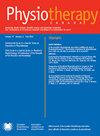Factors Influencing Physical Therapists’ Rehabilitation Prescription in the ICU: Semi-structured Interviews with Qualitative Analysis
IF 0.8
4区 医学
Q4 REHABILITATION
引用次数: 0
Abstract
Despite a plethora of studies on early rehabilitation, specific guidelines for rehabilitation prescription parameters are lacking. The objective of this study was to evaluate how physical therapists determine rehabilitation parameters such as initiation, frequency, intensity, duration, and type of interventions for patients in the ICU. Semi-structured interviews were conducted between April and August of 2021 using video conferencing software following a written interview guide. Purposive sampling was used among interested physical therapists to select those who work across a variety of ICU types with a range of years of ICU experience. We used thematic analysis to identify emerging themes using an inductive approach. We interviewed 30 physical therapists in the USA with 14 (47%) and 16 (53%) having ≤5 years and >5 years of ICU clinical experience, respectively. Nine factors were identified as impacting all rehabilitation prescription parameters (e.g., medical appropriateness, diagnosis/prognosis, and alertness/sedation). For decisions about each parameter there were a set of factors identified: five for initiation (e.g., indication for physical therapy; ventilator settings/oxygen), four for frequency (e.g., baseline function; prior therapy session), three for intensity (e.g., patient appearance and subjective response), nine for duration (e.g., session preparation; quality of performance), and eight for type of intervention (e.g., progressive mobility; patient goals). Interviews examining rehabilitation parameters, revealed that physical therapists consider each of these simultaneously when making decisions about rehabilitation prescription. Furthermore, physical therapists appear to modify to the intervention not only based on patient progress, but by other external factors related to working in an ICU environment (e.g., equipment availability, interruptions for other medical procedures).影响物理治疗师在重症监护病房开具康复处方的因素:半结构式访谈与定性分析
尽管对早期康复进行了大量研究,但仍缺乏康复处方参数的具体指导。本研究旨在评估物理治疗师如何确定重症监护病房患者的康复参数,如干预的开始、频率、强度、持续时间和类型。在 2021 年 4 月至 8 月期间,根据书面访谈指南,使用视频会议软件进行了半结构化访谈。我们在感兴趣的物理治疗师中进行了有目的的抽样调查,以选择那些在各种类型的重症监护室工作过、具有不同年限重症监护室工作经验的物理治疗师。我们采用归纳法进行主题分析,以确定新出现的主题。我们在美国采访了 30 名物理治疗师,其中 14 人(47%)和 16 人(53%)分别拥有≤5 年和 >5 年的 ICU 临床经验。研究发现,有九个因素会影响所有康复处方参数(如医疗适宜性、诊断/预后和警觉/镇定)。在决定每项参数时,还确定了一系列因素:五项是启动因素(如物理治疗的指征;呼吸机设置/氧气),四项是频率因素(如基线功能;之前的治疗疗程),三项是强度因素(如患者的外观和主观反应),九项是持续时间因素(如疗程准备;表现质量),八项是干预类型因素(如渐进移动;患者目标)。通过对康复参数的访谈发现,物理治疗师在决定康复处方时,会同时考虑这些参数。此外,物理治疗师似乎不仅会根据患者的进展情况,还会根据与在重症监护室环境中工作有关的其他外部因素(如设备的可用性、其他医疗程序的中断)来修改干预措施。
本文章由计算机程序翻译,如有差异,请以英文原文为准。
求助全文
约1分钟内获得全文
求助全文
来源期刊

Physiotherapy Canada
REHABILITATION-
CiteScore
1.90
自引率
20.00%
发文量
93
审稿时长
>12 weeks
期刊介绍:
Physiotherapy Canada is the official, scholarly, refereed journal of the Canadian Physiotherapy Association (CPA), giving direction to excellence in clinical science and reasoning, knowledge translation, therapeutic skills and patient-centred care.
Founded in 1923, Physiotherapy Canada meets the diverse needs of national and international readers and serves as a key repository of inquiries, evidence and advances in the practice of physiotherapy.
Physiotherapy Canada publishes the results of qualitative and quantitative research including systematic reviews, meta analyses, meta syntheses, public/health policy research, clinical practice guidelines, and case reports. Key messages, clinical commentaries, brief reports and book reviews support knowledge translation to clinical practice.
In addition to delivering authoritative, original scientific articles and reports of significant clinical studies, Physiotherapy Canada’s editorials and abstracts are presented in both English and French, expanding the journal’s reach nationally and internationally. Key messages form an integral part of each research article, providing a succinct summary for readers of all levels. This approach also allows readers to quickly get a feel for ‘what is already known’ and ‘what this study adds to’ the subject.
Clinician’s commentaries for key articles assist in bridging research and practice by discussing the article’s impact at the clinical level. The journal also features special themed series which bring readers up to date research supporting evidence-informed practice.
The Canadian Physiotherapy Association (CPA) is the national professional association representing almost 15,000 members distributed throughout all provinces and territories. CPA’s mission is to provide leadership and direction to the physiotherapy profession, foster excellence in practice, education and research, and promote high standards of health in Canada.
 求助内容:
求助内容: 应助结果提醒方式:
应助结果提醒方式:


